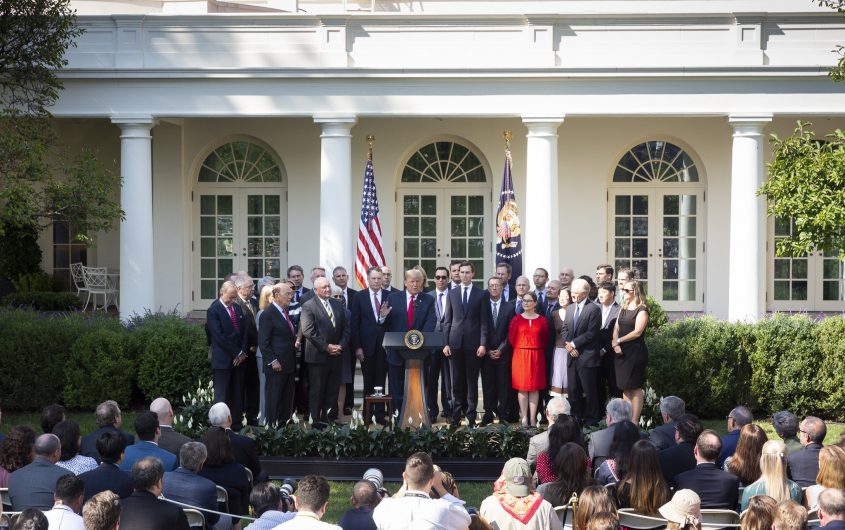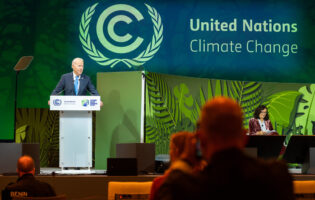
Official White House Photo by Stephanie Chasez
After NAFTA: What the USMCA Means for Germany and Europe

Peter S. Rashish
Vice President; Director, Geoeconomics Program
Peter S. Rashish, who counts over 25 years of experience counseling corporations, think tanks, foundations, and international organizations on transatlantic trade and economic strategy, is Vice President and Director of the Geoeconomics Program at AICGS. He also writes The Wider Atlantic blog.
Mr. Rashish has served as Vice President for Europe and Eurasia at the U.S. Chamber of Commerce, where he spearheaded the Chamber’s advocacy ahead of the launch of the Transatlantic Trade and Investment Partnership. Previously, Mr. Rashish was a Senior Advisor for Europe at McLarty Associates, and has held positions as Executive Vice President of the European Institute, on the Paris-based staff of the International Energy Agency, and as a consultant to the World Bank, the German Marshall Fund of the United States, the Atlantic Council, the Bertelsmann Foundation, and the United Nations Conference on Trade and Development.
Mr. Rashish has testified on the euro zone and U.S.-European economic relations before the House Financial Services Subcommittee on International Monetary Policy and Trade and the House Foreign Affairs Subcommittee on Europe and Eurasia and has advised three U.S. presidential campaigns. He is a member of the Board of Directors of the Jean Monnet Institute in Paris and a Senior Advisor to the European Policy Centre in Brussels. His commentaries have been published in The New York Times, the Financial Times, The Wall Street Journal, Foreign Policy, and The National Interest, and he has appeared on PBS, CNBC, CNN, and NPR.
He earned a BA from Harvard College and an M.Phil. in international relations from Oxford University. He speaks French, German, Italian, and Spanish.
__
October 1 saw the birth of the “United States-Mexico-Canada Agreement” that will replace NAFTA, the 25-year old accord that governed trade among the three North American countries. While the EU (which represents Germany in trade negotiations) was not a party to the deal, the USMCA harbors lessons for the transatlantic trade talks that President Trump and European Commission President Juncker launched at their White House meeting in July of this year.
One important consequence for Europe of the inking of the USMCA is simply that the deal was done.
First the good news. One important consequence for Europe of the inking of the USMCA is simply that the deal was done. Despite Trump’s history of inveighing against trade agreements involving more than two countries (ostensibly because the U.S. can use its sheer size to achieve better outcomes that way), he and his team have entered into an accord with both Canada and Mexico and one that is mostly win-win-win for the three countries involved. In the battle between the pragmatists and the ideologists in the White House and cabinet departments, the first group seems to have won out this time.
Why does this matter for Europe? Because if there is one thing that could derail progress between the U.S. and the EU it is Trumpian trade ideology. Beyond a hostility to multi-country deals, the other core element of the president’s worldview is that the U.S. trade deficit is bad—a sign that the country is losing, being taken advantage of. And the U.S. deficit with Germany (along with China) has specifically been an ongoing focus of White House ire. But at a September 18 press conference Trump seemed to change his tune a bit, saying “And I watch trade deficits, because to me, deficits are very important. They’re not everything, and they’re not exact. Sometimes you can have, you know, a deficit, and that’s not such a bad thing.”
Perhaps the root of this new pragmatism is a realization by the U.S. administration that it will need to rally like-minded countries (Canada, Mexico, the EU, Japan) for the generational effort to reform Chinese trade practices. And that to do that, what will count is not the kind of trade deals the country enters into—bilateral vs. plurilateral vs. multilateral—or reducing U.S. trade deficits, but rather writing new trade rules, whether in the USMCA, between the U.S. and the EU, or in the World Trade Organization.
Perhaps the root of this new pragmatism is a realization by the U.S. administration that it will need to rally like-minded countries for the generational effort to reform Chinese trade practices.
But the USMCA also flashes one yellow light in Europe’s direction. As part of the deal, both Canada and Mexico appear to have been allocated a reasonably generous allowance of automobile imports to the United States that would be guaranteed to enter free of any future tariffs that the Trump administration may decide to place on foreign cars for national security reasons. But at their July meeting, Trump and Juncker agreed to leave auto tariffs out of the new talks on reducing transatlantic trade barriers.
So while Canadian and Mexican producers have been spared, the White House retains a free hand to impose 25 percent tariffs on German and other European car exports if the ongoing Commerce Department investigation finds that foreign cars are indeed a security threat.
It may be that the White House simply wants to retain the leverage that the threat of auto tariffs provides as it talks trade with Europe and will not actually choose to impose them on security grounds on a NATO ally like Germany. Still, no one should be shocked if, after the signing of the USMCA, the EU decides to create a little friendly negotiating leverage of its own.








